Retired faculty who just won't quit
by Jill Elswick
"I took retirement but I didn't retire," says Wolter Fabrycky, former dean of research for Virginia Tech. Fabrycky still conducts sponsored research in the engineering department, directs graduate students, and lectures on campus. His sentiment holds true for numerous other Virginia Tech faculty members who "took retirement" but remain professionally engaged.
These are but a few examples:
Entomologist Mary Ross is testing new materials for cockroach control and researching the genetics of mutant roaches. George Shackelford of the history department writes about Thomas Jefferson; his book, Thomas Jefferson's Travels in Europe 1784-1789, was published in 1995. Milos Hudlicky produces seminal reference works in fluorine chemistry, and fellow chemist Raymond Dessy organizes and teaches unique courses with a practical, interdisciplinary approach.
In mathematics, John Layman teaches classes and supervises undergraduate research. Charlie Aull recently co-edited The Handbook of the History of General Topology (1997).
Kent Roberts, a founder of the veterinary school, lectures in practice management classes. His colleague Bernie Gross researches factors that affect poultry immune systems. Kathleen Wampler, of family and child development, is working to train workers at child-development centers at Marine Corps bases. And the list goes on and on.
Here's a more in-depth look at five faculty retirees who simply refuse to quit.
E. George Stern
They call him "Mr. Nail."
At 85 years old, George Stern still comes every day to his office at the Thomas M. Brooks Forest Products Center. The fact that he's been retired from Virginia Tech since 1981 is merely incidental.
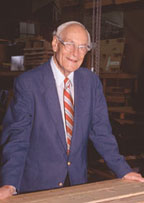 Hired in 1941 to help convert the wood industry to the war effort, Stern pioneered wood sciences at Tech. He invented the particle board, developed and tested over a thousand different nails, and standardized industry definitions of nails, staples, and pallets. For fun, he contested a popular college dictionary's confusion of nails and screws -- and won.
Hired in 1941 to help convert the wood industry to the war effort, Stern pioneered wood sciences at Tech. He invented the particle board, developed and tested over a thousand different nails, and standardized industry definitions of nails, staples, and pallets. For fun, he contested a popular college dictionary's confusion of nails and screws -- and won.
Shortly after retirement, Stern was asked to develop national standards for railings, such as those on staircases -- a project that took 10 years. "I tested more railings than anybody else," he says. His next step is to internationalize these standards.
Stern has recently written papers on subjects such as bridge-plate girders and measuring the quality of pallet nails and staples. For his family, he wrote Episodes in My Life, an autobiography reaching back into his childhood in Germany during World War I.
In 1997, the Stern Fastener and Pallet Research Laboratory in the Brooks Center was named in Stern's honor. His pace that year remained steady. As part of the partnership between Tech and Vyatka State Technical University in Kirov, Russia, he organized a tour in Russia on preserving antiquities. He received a patent for an improved metal plate for end-plating railroad ties. And he raised $30,000 from the pallet industry to fund a beautification project, which may feature a sculpture of a nail and a pallet, along Tech Center Drive.
Another of Stern's current projects is chairing an International Standards Organization (ISO) task force to harmonize British and American English terms in an international building and civil engineering vocabulary. This ensures, for example, that the American word "elevator" will appear in parentheses beside the British word "lift" in ISO papers.
Work, Stern says, is essential for life: "I have a lot to do, which is fortunate. Because if you don't have anything to do, you're apt to die."
Michael Kosztarab
Since Michael Kosztarab joined the entomology department in 1962, Tech's 110-year-old insect collection has grown from 70,000 to over 1 million specimens. Kosztarab curated the insect collection during his entire career as a professor at Tech. Retired since 1992, he's still serving as curator.
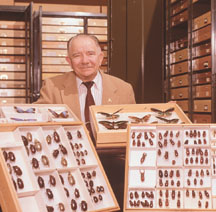
Tech's insect collection is well-known and active, with hundreds of loans being made over the years. Kosztarab recently sent specimens to the Smithsonian Institution and the National University of Australia.
In order to house the large collection properly, Kosztarab began pushing in 1968 to start a branch of Virginia's Museum of Natural History at Virginia Tech. He became founding director when the branch finally opened in its downtown Blacksburg location in 1990.
Because the museum's current facility is too small to accommodate the entire insect collection -- not to mention Tech's impressive number of birds, mammals, fossils, plants, fungi, rocks, minerals, and gems -- Kosztarab's current mission is to find the means to build a new facility on the Tech campus.
For Kosztarab, retirement has made possible the completion of two books. The first, Scale Insects of Northeastern North America (1996), is a compendium of 254 species of the tiny pests and represents 37 years of work; he contributed this book to the U.S. National Biological Service (NABIS), a project to describe the fauna of the United States. The second book, Transylvanian Roots: The True Life Adventures of a Hungarian American (1997), is an autobiography recounting, among other incidents, Kosztarab's escape from the Nazis and the Soviets in Hungary.
In honor of Kosztarab's lifetime of contributions to entomology, the Virginia Museum of Natural History Foundation last January awarded him the Thomas Jefferson Medal for Outstanding Contributions to Natural Science.
But, achievements and honors aside, Kosztarab continues to work after retirement because insects are his hobby. He enjoys guest lecturing, consulting on insect biodiversity issues, and identifying scale insects or mealybugs sent by Virginians to the Insect Identification Lab.
Insects, to Kosztarab, are beautiful. Who else would describe a mealybug as 'nice'? Who else would persuade the state legislature to vote for the indigenous tiger swallowtail butterfly instead of the imported Chinese mantis as Virginia's state insect?
Only a man who loves being an entomologist.
"One thing I try to instill in my students," he says, "is to love what you're doing. Try to make your profession your hobby."
John Cairns Jr.
A scientist inspired by detective stories, John Cairns Jr. has been drawn to the problem of pollution since he was a graduate student. He built a career studying the effects of various pollutants on fish, invertebrates, and microorganisms. His research on how ecosystems recover after disasters has helped accelerate healing in environments ranging from strip mines in southwestern Virginia to the Ohio and Thames rivers.
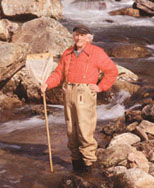 Cairns joined Tech's biology department in 1968; he became director of the Center for Environmental and Hazardous Materials in 1970, a post he held until retirement in 1995. He is a member of the U.S. National Academy of Sciences and other prestigious organizations; he has received a wealth of state, national, and international awards. His publications, including 54 books, number over 1,300.
Cairns joined Tech's biology department in 1968; he became director of the Center for Environmental and Hazardous Materials in 1970, a post he held until retirement in 1995. He is a member of the U.S. National Academy of Sciences and other prestigious organizations; he has received a wealth of state, national, and international awards. His publications, including 54 books, number over 1,300.
Retirement hasn't stopped Cairns. His recent work focuses on the concept of sustainable use, which roughly means that human beings must restore to the environment whatever they take from it. As Cairns explains in an article in Ecotoxicology (1998), under a paradigm of sustainable use, the lifecycle of products will include reincorporating used materials into natural systems.
Last June, Cairns presented recommendations to the International Joint Commission on the Great Lakes for sustainable use of the lakes. In the November 1997 issue of Environmental Health Perspectives, he defined his goals and conditions for a sustainable world. In last year's premier issue of Sustainable Communities Review, he proposed that each generation plan to sustain the planet's resources for the next seven generations.
Cairns expressed his concern for future generations as a signer of the World Scientists' Call for Action at the Kyoto Climate Summit in December of 1997. All of the world's national academies and almost all of the living Nobel laureates prepared a statement for President Clinton advocating reduction in fossil fuels until more is known about the global warming threat.
In May 1998, as a cooperative effort between Tech and the Wilderness Conservancy at Mountain Lake, Cairns will be among the instructors of a four-day, interdisciplinary course he has designed on sustainability. In the meantime, he's writing two books, one on sustainable use of water ecosystems and another on his career.
When asked if he is an optimist, Cairns states, "I range all the way from controlled panic to optimism....I'm optimistic about what we could do. I'm a little pessimistic about what we will do until a lot of people suffer."
As for nature itself, Cairns is not worried. "Nature will be fine....Things are living in boiling vents in the ocean, nine miles down in the dirt. We're not going to kill all those things." Whether human society will survive is another matter. That's what worries Cairns.
Why does Cairns continue his work, even though he knows he cannot restore ecosystems as fast as they are being damaged? After so many years, he says, "You get attached."
Dean Carter
The perfectly symmetrical, bell-shaped, wooden sculpture of Saint Anne stands about a foot tall. Her head is spherical, her face an abstraction. Her hands are clasped neatly at her waist. Sculptor Dean Carter has just finished creating her for a friend. He had no preconceived images of his subject and he used no models.
"I'm an intuitive artist," he says.
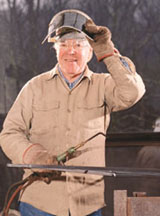 To see examples of Carter's work on the Tech campus, you don't have to walk far. His Madonna and Child sculpture is in Wallace Hall. Stuart Cassell's portrait head resides in Cassell coliseum; one of Edward Lane is in Lane Stadium. The veterinary building features Carter's outdoor marble animal sculpture of a dog, a swan, and a bullock. Vet students rub the nose of the dog for good luck.
To see examples of Carter's work on the Tech campus, you don't have to walk far. His Madonna and Child sculpture is in Wallace Hall. Stuart Cassell's portrait head resides in Cassell coliseum; one of Edward Lane is in Lane Stadium. The veterinary building features Carter's outdoor marble animal sculpture of a dog, a swan, and a bullock. Vet students rub the nose of the dog for good luck.
Two portrait heads, one of Tech's architecture department founder Clinton Cowgill and one of Bauhaus art and architecture movement originator Walter Gropius, are in Cowgill Hall. Gropius never sat for anyone, but Carter. Recently Carter donated a portrait head of Gropius to the Huntington (W.Va.) Museum of Art, which was partially designed by the Bauhaus legend.
Carter joined Tech's architecture department in 1950 to teach sculpting. At that time, Tech had no art department. Carter would later help establish the art department and become its head for 10 years. Although he retired in 1995, Carter is still active sculpting, exhibiting, and guest lecturing. Last year, he sculpted a portrait head of the late Tech architecture professor Leonard Currie; the work awaits dedication in Cowgill Hall.
In 1995, Carter completed bronze door pulls in the shape of fish and the four evangelists Matthew, Mark, Luke, and John for the Ikenoue Chapel in Japan. Akira Inadomi '60, Carter's former student and the chapel's architect, commissioned the project.
In the past two years, Carter has exhibited work at the Green Hill Gallery in Greensboro, N.C., the Fayetteville Museum of Art, and the Southern Highlands Handicraft Guild. Work keeps him looking ahead: "I like to think about the future," he says.
John Costain
While teaching groundwater hydrology and geophysics at Tech, John Costain synthesized ideas from both courses and hit on a new theory of earthquakes. He called his hypothesis "hydroseismicity." When first proposed in 1987, Costain's idea -- that deep intraplate earthquakes can be triggered by near-surface changes in groundwater levels, and that these changes can actually be correlated with changes in surface streamflow -- met with disapproval.
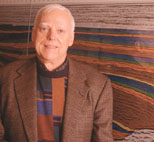 Ten years later, in his retirement, Costain is beginning to see his theory vindicated. Last December's issue of the Bulletin of the Seismological Society of America contained a paper acknowledging the hypothesis of hydroseismicity. And researchers from around the world, including a Russian geophysicist studying earthquakes in the Baltic Sea, have contacted Costain to affirm their belief.
Ten years later, in his retirement, Costain is beginning to see his theory vindicated. Last December's issue of the Bulletin of the Seismological Society of America contained a paper acknowledging the hypothesis of hydroseismicity. And researchers from around the world, including a Russian geophysicist studying earthquakes in the Baltic Sea, have contacted Costain to affirm their belief.
"It's a thrilling experience; there's nothing like it," says Costain of the recent attention to his idea.
Costain came to Tech in 1967 to help set up a geophysics program. His main areas of research have been in heat flow and reflection seismology. He retired in 1996 but still teaches courses in groundwater hydrology and reflection seismology. Over his career, Costain has brought Tech geophysics-research funding in excess of $12 million dollars.
Many research grants came from the National Science Foundation, U.S. Department of Energy (DOE), and companies such as Chevron, who rely on Costain's vibroseis reflection seismic data system to find oil. This technique records data under the earth in the same way ultrasound is used to look at a baby in the womb.
Costain's current projects include co-writing Volume 1 of the 20-volume series The Handbook of Geophysical Exploration, to be published in 1999. He's also bringing Tech's geothermal web page up to date with data he and his colleagues collected from eastern states. The site, at http://rglsun1.geol.vt.edu, is sponsored by a grant from the DOE. It gets a lot of nationwide traffic from geophysicists, geologists, and people simply interested in alternate energy sources. The site features a Blacksburg home heated by geothermal energy.
Costain is also working on a grant proposal to the DOE to study fractures in the earth and their transfer of water. Through this research, new sources of potable water may be found.
"There's potential for fresh drinking water anywhere, if you know where to look for it," says Costain. The quest for geophysical discoveries keeps him hard at work.
Jeffrey Douglas, information officer for the veterinary school, summed up the motivation of his school's retired faculty members who remain professionally active: "Their love for their work and their desire to contribute transcend any interest in financial gain."
His comment applies equally well to all of Virginia Tech's working faculty retirees, whose years of service and amassed knowledge represent the very bedrock of our university.
Back to Features Page
Home | News | Features | Research | Philanthropy | President's Message | Athletics | Alumni | Classnotes | Editor's Page

 Hired in 1941 to help convert the wood industry to the war effort, Stern pioneered wood sciences at Tech. He invented the particle board, developed and tested over a thousand different nails, and standardized industry definitions of nails, staples, and pallets. For fun, he contested a popular college dictionary's confusion of nails and screws -- and won.
Hired in 1941 to help convert the wood industry to the war effort, Stern pioneered wood sciences at Tech. He invented the particle board, developed and tested over a thousand different nails, and standardized industry definitions of nails, staples, and pallets. For fun, he contested a popular college dictionary's confusion of nails and screws -- and won.

 Cairns joined Tech's biology department in 1968; he became director of the Center for Environmental and Hazardous Materials in 1970, a post he held until retirement in 1995. He is a member of the U.S. National Academy of Sciences and other prestigious organizations; he has received a wealth of state, national, and international awards. His publications, including 54 books, number over 1,300.
Cairns joined Tech's biology department in 1968; he became director of the Center for Environmental and Hazardous Materials in 1970, a post he held until retirement in 1995. He is a member of the U.S. National Academy of Sciences and other prestigious organizations; he has received a wealth of state, national, and international awards. His publications, including 54 books, number over 1,300.
 To see examples of Carter's work on the Tech campus, you don't have to walk far. His Madonna and Child sculpture is in Wallace Hall. Stuart Cassell's portrait head resides in Cassell coliseum; one of Edward Lane is in Lane Stadium. The veterinary building features Carter's outdoor marble animal sculpture of a dog, a swan, and a bullock. Vet students rub the nose of the dog for good luck.
To see examples of Carter's work on the Tech campus, you don't have to walk far. His Madonna and Child sculpture is in Wallace Hall. Stuart Cassell's portrait head resides in Cassell coliseum; one of Edward Lane is in Lane Stadium. The veterinary building features Carter's outdoor marble animal sculpture of a dog, a swan, and a bullock. Vet students rub the nose of the dog for good luck.
 Ten years later, in his retirement, Costain is beginning to see his theory vindicated. Last December's issue of the Bulletin of the Seismological Society of America contained a paper acknowledging the hypothesis of hydroseismicity. And researchers from around the world, including a Russian geophysicist studying earthquakes in the Baltic Sea, have contacted Costain to affirm their belief.
Ten years later, in his retirement, Costain is beginning to see his theory vindicated. Last December's issue of the Bulletin of the Seismological Society of America contained a paper acknowledging the hypothesis of hydroseismicity. And researchers from around the world, including a Russian geophysicist studying earthquakes in the Baltic Sea, have contacted Costain to affirm their belief.